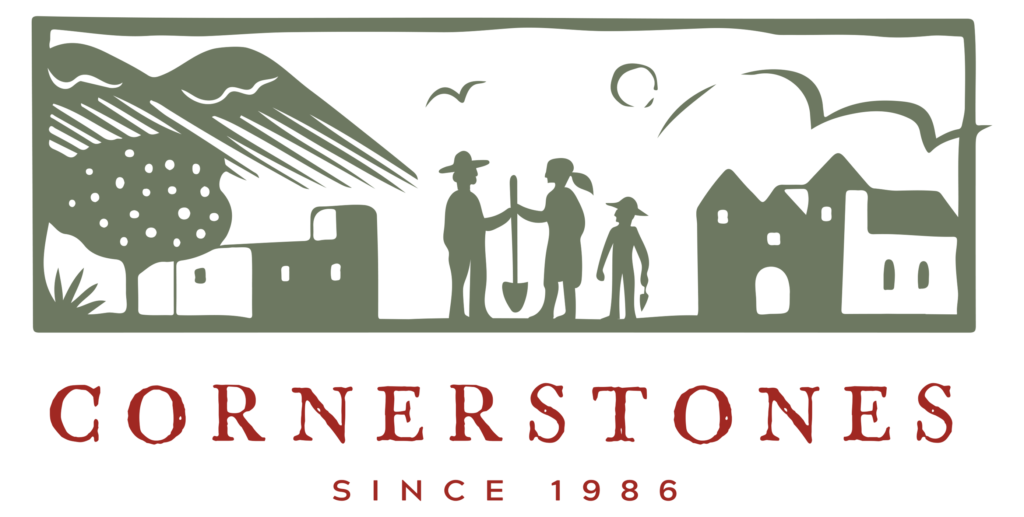A Letter from Executive Director Tracey Enright
Photos by Tracey Enright. Click to zoom.
Over the past few months, I looked back at Cornerstones restoration projects and described what we are doing in those same communities today. Our best collaborations are long-term relationships. Many of the communities that we work in are small, and their wonderful stories are often not well known outside the immediate area.
With this column, I am diving into the story and plans for one of our most high-profile projects: San Miguel Chapel, which is often cited as the oldest church in the United States. In 2010, Cornerstones collaborated with several organizations to launch an ambitious restoration project nearly 10 years in the making. Over the decade since, we have continued to maintain and restore portions of the Chapel. Today, we are moving forward with a new type of project at the Chapel, one that is potentially a game changer for historic preservation.
If you know me, you probably know I am a fierce advocate for more opportunities to tell the history of the Western United States. Even before I joined Cornerstones, I took friends and family who visited Santa Fe to San Miguel Chapel. I encouraged them to look closely at and touch the exterior walls. We discussed the difference between adobe mud plaster and the cement stucco that covers many buildings in Santa Fe. I told visitors that a local organization removed the cement stucco and returned the walls to mud plaster. I never guessed that I would someday lead that organization.
The story of San Miguel, like the building itself, is fascinating and contains many layers. Entire books and scholarly papers have been written on its history. Cornerstones’ files on San Miguel Chapel are well over a foot wide.
I like this drawing from Stanley Stubbs and Bruce T. Ellis’ 1955 publication Archeological Investigations at the Chapel of San Miguel and the Site of La Castrense because it shows the many layers of history uncovered in the 1955 restoration.
Inside the Chapel, I am intrigued by the pre-1628 alter steps, uncovered in the 1955 restoration that included an extensive archeological survey. They are visible today under glass several feet below the modern altar. This survey also discovered Native American floors, potsherds, and garbage below one of the original side chapels. I like to try to imagine the lives of people who have experienced this spot in its various uses.
Obviously, there’s more history than I can cover in this column, so I will skip to where Cornerstones became part of the story. In 2001, Cornerstones joined a group that came together around concerns about the physical condition of the Chapel. After years of planning, fundraising, and assessment, in June of 2010 the restoration project began. The most dramatic visible change was following the removal of exterior cement plaster and repairs to the walls and base; the chapel’s exterior was plastered with three to six thin layers of earthen plaster.
Watch this video for some gorgeous images of the church and action shots of the restoration:
We often speak about how our projects wouldn’t happen without the help of volunteers: 1,415 volunteers contributed 7,095 hours of labor to the initial restoration of San Miguel. The Chapel is privately owned by St. Michael's High School, based on a Lasallian Christian Brothers tradition. St. Michael’s students volunteered for the mud plastering to contribute to the project. Major funding came from The Getty Foundation, The Catholic Foundation, The National Park Service, The National Endowment for the Arts, The History Channel and Save America’s Treasures, and Heritage Hotels among many others.
Since that time Cornerstones has worked closely with the High School to maintain the chapel.
If you live near Santa Fe and you haven’t been to San Miguel Chapel lately, please take a moment to visit and get up close to the exterior walls. Notice the difference between adobe and cement stucco.
With a bit of planning, you can see the interior or attend a performance. As I write this the Chapel is open to visitors, and live performances have resumed. (Check the website for performance dates: https://www.sanmiguelchapelsantafe.org/)
Live performances are a wonderful way to experience this building as the active space that it still is today. San Miguel Chapel, like Cornerstones’ other projects, is still very much alive and useful to the community, not a static artifact of the past.
San Miguel Chapel is a tangible representation of New Mexico’s long layered history, a gathering space for artistic expression, and soon it will be an example of adapting historic structures to modern times in a sensitive manner. For the last several years, with funding from a Richard Moe Family Foundation Grant, Remy’s Good Day Fund, and the San Miguel Preservation Program supported by St Michael’s High School, Cornerstones has been exploring how to bring solar energy to San Miguel Chapel.
Today, that plan is coming together. Stay tuned, in a future post I’ll move from history and preservation to technology and engineering stories.

